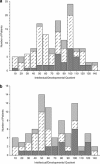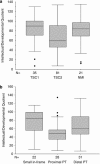Genotype and cognitive phenotype of patients with tuberous sclerosis complex
- PMID: 22189265
- PMCID: PMC3330219
- DOI: 10.1038/ejhg.2011.241
Genotype and cognitive phenotype of patients with tuberous sclerosis complex
Abstract
Tuberous sclerosis complex (TSC) is an autosomal dominant, multisystem disorder, which affects 1 in 6000 people. About half of these patients are affected by mental retardation, which has been associated with TSC2 mutations, epilepsy severity and tuber burden. The bimodal intelligence distribution in TSC populations suggests the existence of subgroups with distinct pathophysiologies, which remain to be identified. Furthermore, it is unknown if heterozygous germline mutations in TSC2 can produce the neurocognitive phenotype of TSC independent of epilepsy and tubers. Genotype-phenotype correlations may help to determine risk profiles and select patients for targeted treatments. A retrospective chart review was performed, including a large cohort of 137 TSC patients who received intelligence assessment and genetic mutation analysis. The distribution of intellectual outcomes was investigated for selected genotypes. Genotype-neurocognitive phenotype correlations were performed and associations between specific germline mutations and intellectual outcomes were compared. Results showed that TSC1 mutations in the tuberin interaction domain were significantly associated with lower intellectual outcomes (P<0.03), which was also the case for TSC2 protein-truncating and hamartin interaction domain mutations (both P<0.05). TSC2 missense mutations and small in-frame deletions were significantly associated with higher IQ/DQs (P<0.05). Effects related to the mutation location within the TSC2 gene were found. These findings suggest that TSC2 protein-truncating mutations and small in-frame mutations are associated with distinctly different intelligence profiles, providing further evidence that different types and locations of TSC germline mutations may be associated with distinct neurocognitive phenotypes.
Figures




References
-
- van Slegtenhorst M, de Hoogt R, Hermans C, et al. Identification of the tuberous sclerosis gene TSC1 on chromosome 9q34. Science. 1997;277:805–808. - PubMed
-
- European Chromosome 16 Tuberous Sclerosis, Consortium Identification and characterization of the tuberous sclerosis gene on chromosome 16. Cell. 1993;75:1305–1315. - PubMed
-
- Garami A, Zwartkruis FJ, Nobukuni T, et al. Insulin activation of Rheb, a mediator of mTOR/S6K/4E-BP signaling, is inhibited by TSC1 and 2. Mol Cell. 2003;11:1457–1466. - PubMed
-
- van Slegtenhorst M, Nellist M, Nagelkerken B, et al. Interaction between hamartin and tuberin, the TSC1 and TSC2 gene products. Hum Mol Genet. 1998;7:1053–1057. - PubMed
Publication types
MeSH terms
Substances
Grants and funding
LinkOut - more resources
Full Text Sources
Medical

